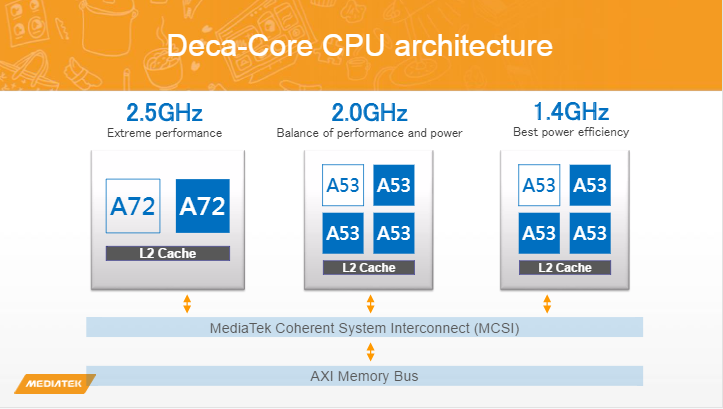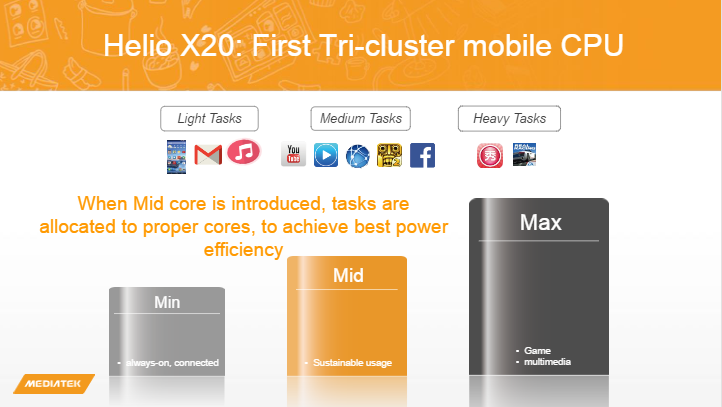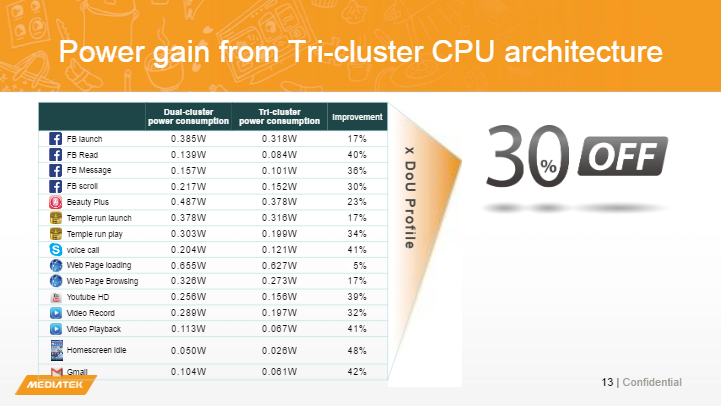Helio X20 Mediatek Wants To Be Chip Powerhouse; 20nm Process Slows It Down
Mediatek announced its next-generation high-end SoC, the Helio X20. The chip is unique in its design, as it features not one, not two (like big.LITTLE), but three CPU clusters for a total of 10 CPU cores. Indeed, the Mediatek Helio X20 is the world's first deca-core mobile chip.
The Helio X20 is also Mediatek's first Cortex-A72-based chip. Cortex-A72 is ARM's next-generation high-end CPU core and successor to the Cortex-A57. It's more efficient and more powerful than its predecessor, and in the case of Helio X20, will be built on TSMC's 20nm process.
The Helio X20 chip comes with a dual-core 2.5 GHz Cortex-A72 cluster, a quad-core 2.0 GHz Cortex-A53 cluster for medium tasks, and another quad-core 1.4 GHz Cortex-A53 cluster for lighter and on-going tasks.
The Mediatek Coherent System Interconnect and the CorePilot 3.0 advanced scheduling algorithm are used to manage the three clusters and ensure that the right cluster is used at the right time and for the right task. Otherwise, the whole system could become inefficient, either in terms of power consumption or in terms of performance.
Mediatek seems to believe that different CPUs should be used for different tasks on a mobile device. For instance, a higher-performance mobile CPU should be used for gaming in order to provide strong graphics performance and an enjoyable user experience in general -- even at the cost of lower battery life.
Mediatek is running the high-end Cortex-A72 cores at 2.5 GHz each, which seems quite high. Even if Cortex-A72 is significantly more efficient than Cortex-A57, when playing games, those cores will have to run close to their peak performance and for a relatively long time (in mobile time). It will be interesting to see whether the chip can handle such high performance on a 20nm process.
Mediatek said it wanted to have a tri-cluster CPU because the dual-cluster big.LITTLE setup was just not enough -- neither in low-power nor peak performance.
Get Tom's Hardware's best news and in-depth reviews, straight to your inbox.
This is an interesting claim because the Helio X20's low-end cluster also doesn't max out at a very low frequency. The lowest (maximum) clock speed of its clusters is 1.4 GHz, which historically is quite high for big.LITTLE's low-end cluster. That's without even counting that the Cortex-A53 is also slightly more powerful and power-hungry than its predecessor, the Cortex-A7. Even so, Mediatek showed that its tri-cluster CPU managed to improve on a dual-cluster design in terms of power consumption.
It's true that we haven't seen mobile chips go to this level of performance at the high end before, in part because Cortex-A72 is a brand-new next-generation core, and in part because even Samsung's 14nm chip only goes as high as 2.2 GHz. Therefore, Mediatek may indeed have the highest-performance big.LITTLE-like chip yet.
One of the reasons we're starting to see ARM chip makers push beyond even eight-core chips now is because ARM cores are so cheap. Adding a couple of extra cores doesn't add too much to the cost of the SoC, especially when we're talking about tiny Cortex-A53 cores.
This is not something other chip makers such as Intel can easily do, even with its mobile CPUs. Every extra core costs significantly more money, which is why Intel's mainstream PC chips are mainly dual-core and why its mobile Atom chips are still only quad-core.
Instead of creating a cluster that's highly optimized for a certain class of applications, Intel is likely to continue with its Turbo-Boost strategy (low base clock speeds, temporary high speed bursts). This has the advantage of keeping costs the same while also continuing to increase the burst speed of the CPU, which in turn helps it solve some tasks more quickly and perform well in most benchmarks.
However, it also means that the "low-end" tasks will be served by the same "wide" microarchitecture, which is less efficient than using a simpler CPU, even when at a low clock speed.
The Turbo Boost strategy also has a major disadvantage in gaming, because in games you're only really going to get the base clock speed, maxed out. The chip will not be able to keep Turbo Boost enabled for long. If you see a chip that promises 1.2 GHz base speed with 2.5 GHz Turbo-Boost, the lower speed is what games should be using over the period of time you're playing the game.
Mediatek is also pushing the chip's multimedia capabilities and its overall performance. The Helio X20 will support EIS, OIS and AIS (Automatic Image Stabilization) stabilization technologies for video and images, 120 Hz displays (as part of a new trend that's also going to be great for VR headsets), and advanced vision processing by CPU/GPU and ISP heterogeneous computing.
Mediatek's third major announcement for the Helio X20 was its own LTE modem, which supports worldwide coverage. It's a Cat. 6 LTE modem with download speeds up to 300 Mbps and 20+20 (MHz) carrier aggregation.
Mediatek's Helio X20 SoC is expected to ship in products by the end of the year. Most should only see it in Q1 2016, as the chip is only starting to sample in Q3 2015, and it takes a couple of quarters to reach the market.
The Helio X20 makes many promises, and it may even end up fulfilling most of them. However, it's uncertain how it will compete next year against 14nm and 16nm FinFET chips. If Mediatek would have been more aggressive about the process node it chose, it would have had a chip that competes not just against "2nd-tier" high-end chips, but the highest-end mobile chips on the market. At 20nm, that's unlikely to happen as it won't be able to beat an Exynos 8 or a Snapdragon 820/830 built on 14/16nm FinFET.
Either way, Mediatek has been making strong progress with its chips in a few short years, going from making SoCs only for low-end smartphones and tablets to competing with the best in the market. Mediatek may just rise to become the third-party chip making competitor Qualcomm needs (unless Samsung also decides to start selling its chips to others, but that seems unlikely for now).
Follow us @tomshardware, on Facebook and on Google+.
Lucian Armasu is a Contributing Writer for Tom's Hardware US. He covers software news and the issues surrounding privacy and security.
-
Janithdalw Apple A9 will show everyone who hype with more cores that core count doesn't mean anything.Reply
Better 2 Cores > Weak 10 Cores -
amdfangirl This is crazy...Reply
What is the latency from switching between all those cores?
Not to mention the power required to start.stop.transfer between the cores? -
garrlker ReplyApple A9 will show everyone who hype with more cores that core count doesn't mean anything.
Better 2 Cores > Weak 10 Cores
AFAIK you can't use all 10 cores at the same time. The OS will switch to a different cluster depending on the task at hand: dual core beastly cluster for gaming, quad core medium cores for skype/watching videos, quad core light weight cores for web browsing and when the phone is locked. -
zodiacfml brilliant. more cores, better sales in expanding markets but having the latest process node is crucial for longer term success. I see an AMD here providing more cores to the consumers to compete with Intel's.Reply -
jasonelmore why have two sets of a53 clusters? Why not just clock manage the 4x a53 cluster, and that gets rid of 4 cores and still accomplishes the same thingReply





